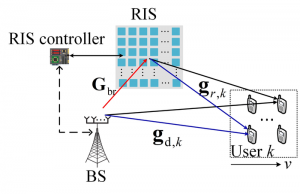Researchers deploy RIS technology in a wireless communication system to analyse the effects of channel ageing in next-generation wireless communications.
In wireless communications, channels can not only change, but they can also age. For contemporary systems, the connections between the transmitter and the receiver, user movement and power dissipation can all break down over time. According to an international collaboration of researchers studying the topic of reconfigurable intelligent surface (RIS)-assisted systems, understanding how channels age in future systems, as well as how to mitigate such issues, is crucial to developing the next generation of wireless communications.
RIS technology is greatly anticipated for its potentially transformative role in future wireless communication systems. RIS-assisted systems include individually programmable and controlled circuits that can dynamically reflect signals and have the possible capability to achieve 6G wireless communications, according to the first author, Yan Zhang, at the School of Electronics and Information Engineering, Beijing Jiaotong University.
RIS-assisted communication systems
“Investigating the performance of RIS-assisted communication systems under the condition of channel ageing can verify whether deploying an RIS in a wireless communication system can reduce the adverse impact of channel ageing on system performance and how much performance gain it can bring,” Zhang explained. “This is helpful to provide a theoretical basis for the system optimisation design of RIS-assisted communication systems.”
All three components of the communication system can move: the RIS may be a satellite, the base station moves as the Earth rotates and the users are unpredictably mobile. Add in modifications to the communication environment, such as physical barriers or weather interference, and the channels of communication will continuously change over time.
“These factors lead to the so-called channel ageing phenomenon where the channels vary across time with correlated channel variables in a transmission,” Zhang added. “Channel ageing results in a mismatch between the current and estimated channels that degrades the system performance. But, to the best of our knowledge, there is a lack of studies on the impact of channel ageing on RIS-assisted communications systems. Since RIS will help to evolve wireless communication, it is of great importance to analyse how RISs can improve the channel quality with user mobility.”
Next-generation wireless communications
The researchers examined how deploying RIS technology in a wireless communication system affects the adverse impact of channel ageing on system performance. They modelled a system in which a base station simultaneously sends signals to an RIS and directly to individual cell phone users. The RIS reflects the signal to the same users, duplicating and strengthening the signal. In this model, the RIS and base station remain stationary, while the users are moving in a single direction at the same velocity.
The system mathematically estimates the best channel to send a signal, depending on location, movement and potential barriers. The channel varies from the time it is estimated to when it is used to send or detect the signal — this is the ageing phenomenon.

Chanel ageing
“Due to the existence of an extra end-to-end signal propagation path established by the RIS, we found that RISs can reduce the adverse effects of channel ageing on the communication system, as well as improve the overall system performance, compared to systems without an RIS,” Zhang explained. “Moreover, the system performance improved as the total transmit power and the number of antennas at the base station, the number of the RIS’s reflecting elements and the temporal correlation coefficient increased.”
However, while the RIS can increase transmission capacity by adding reflecting elements, it does not have infinite capacity since it will eventually become saturated.
“This analysis is helpful in providing a theoretical basis for the system optimisation design of RIS-assisted communication systems,” Zhang said. “The study can be further generalised along with several promising future work directions. For example, we can apply this approach to the study of spatially correlated fading and more efficient channel estimation methods.”









